2018 Hyundai Elantra remove seats
[x] Cancel search: remove seatsPage 29 of 526

2-12
Safety system of your vehicle
Armrest (if equipped)
The armrest is located in the center of
the rear seat. Pull the armrest down by
using the strap from the seatback to use
it.
If your car is not equipped with a rear
armrest, the rear cup holders are located
at the back of the center console.
Head Restraints
The vehicle's front and rear seats have
adjustable head restraints. The head
restraints provide comfort for passen-
gers, but more importantly they are
designed to help protect passengers
from whiplash and other neck and spinal
injuries during an accident, especially in
a rear impact collision.
OAD035023
Be careful when loading cargo
through the rear passenger seats
to prevent damage to the vehicle
interior.
When cargo is loaded through
the rear passenger seats, ensure
the cargo is properly secured to
prevent it from moving while driv-
ing.
Unsecured cargo in the passen-
ger compartment can cause dam-
age to the vehicle or injury to it's
occupants.
CAUTION
To reduce the risk of serious injury
or death in an accident, take the fol-
lowing precautions when adjusting
your head restraints:
Always properly adjust the head
restraints for all passengers
BEFORE starting the vehicle.
NEVER let anyone ride in a seat
with the head restraints removed.(Continued)
WARNING
Page 32 of 526
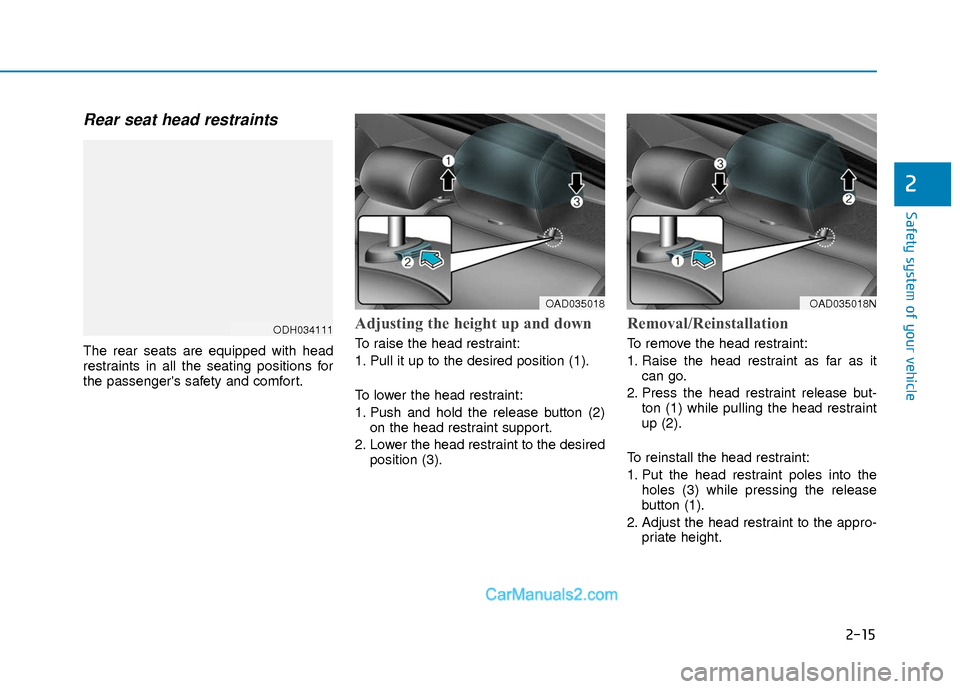
2-15
Safety system of your vehicle
2
Rear seat head restraints
The rear seats are equipped with head
restraints in all the seating positions for
the passenger's safety and comfort.
Adjusting the height up and down
To raise the head restraint:
1. Pull it up to the desired position (1).
To lower the head restraint:
1. Push and hold the release button (2)on the head restraint support.
2. Lower the head restraint to the desired position (3).
Removal/Reinstallation
To remove the head restraint:
1. Raise the head restraint as far as itcan go.
2. Press the head restraint release but- ton (1) while pulling the head restraint
up (2).
To reinstall the head restraint:
1. Put the head restraint poles into the holes (3) while pressing the release
button (1).
2. Adjust the head restraint to the appro- priate height.ODH034111
OAD035018OAD035018N
Page 35 of 526
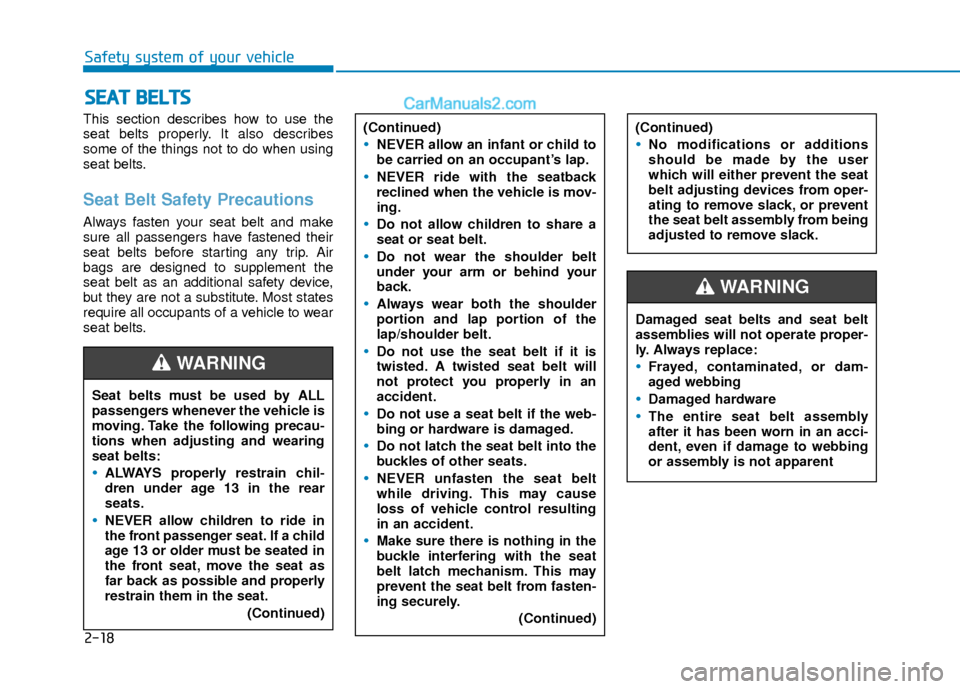
2-18
Safety system of your vehicle
This section describes how to use the
seat belts properly. It also describes
some of the things not to do when using
seat belts.
Seat Belt Safety Precautions
Always fasten your seat belt and make
sure all passengers have fastened their
seat belts before starting any trip. Air
bags are designed to supplement the
seat belt as an additional safety device,
but they are not a substitute. Most states
require all occupants of a vehicle to wear
seat belts.
S SE
E A
A T
T
B
B E
EL
LT
T S
S
Seat belts must be used by ALL
passengers whenever the vehicle is
moving. Take the following precau-
tions when adjusting and wearing
seat belts:
ALWAYS properly restrain chil-
dren under age 13 in the rear
seats.
NEVER allow children to ride in
the front passenger seat. If a child
age 13 or older must be seated in
the front seat, move the seat as
far back as possible and properly
restrain them in the seat.
(Continued)
WARNING
(Continued)
NEVER allow an infant or child to
be carried on an occupant’s lap.
NEVER ride with the seatback
reclined when the vehicle is mov-
ing.
Do not allow children to share a
seat or seat belt.
Do not wear the shoulder belt
under your arm or behind your
back.
Always wear both the shoulder
portion and lap portion of the
lap/shoulder belt.
Do not use the seat belt if it is
twisted. A twisted seat belt will
not protect you properly in an
accident.
Do not use a seat belt if the web-
bing or hardware is damaged.
Do not latch the seat belt into the
buckles of other seats.
NEVER unfasten the seat belt
while driving. This may cause
loss of vehicle control resulting
in an accident.
Make sure there is nothing in the
buckle interfering with the seat
belt latch mechanism. This may
prevent the seat belt from fasten-
ing securely.(Continued)
(Continued)
No modifications or additions
should be made by the user
which will either prevent the seat
belt adjusting devices from oper-
ating to remove slack, or prevent
the seat belt assembly from being
adjusted to remove slack.
Damaged seat belts and seat belt
assemblies will not operate proper-
ly. Always replace:
Frayed, contaminated, or dam-
aged webbing
Damaged hardware
The entire seat belt assembly
after it has been worn in an acci-
dent, even if damage to webbing
or assembly is not apparent
WARNING
Page 46 of 526

2-29
Safety system of your vehicle
2
Selecting a Child Restraint
System (CRS)
When selecting a CRS for your child,
always:
Make sure the CRS has a label certify-ing that it meets applicable Federal
Motor Vehicle Safety Standards
(FMVSS 213).
Select a child restraint based on your child’s height and weight. The required
label or the instructions for use typical-
ly provide this information.
Select a child restraint that fits the vehicle seating position where it will be
used.
Read and comply with the warnings and instructions for installation and use
provided with the child restraint sys-
tem.
Child restraint system types
There are three main types of child
restraint systems: rear-facing seats, for-
ward-facing seats, and booster seats.
They are classified according to the
child’s age, height and weight.
Rear-facing child seats
(Continued)
If the vehicle head restraint pre-
vents proper installation of a
child seat (as described in the
child restraint system manual),
the head restraint of the respec-
tive seating position shall be
readjusted or entirely removed.
Do not use an infant carrier or a
child safety seat that "hooks"
over a seatback, it may not pro-
vide adequate protection in an
accident.
After an accident, have a
HYUNDAI dealer check the child
restraint system, seat belts, teth-
er anchors and lower anchors.
NEVER install a child or infant
restraint in the front passenger’s
seat.
Placing a rear-facing child restraint
in the front seat can result in SERI-
OUS INJURY or DEATH if the child
restraint is struck by an inflating air
bag.
WARNING
Page 48 of 526
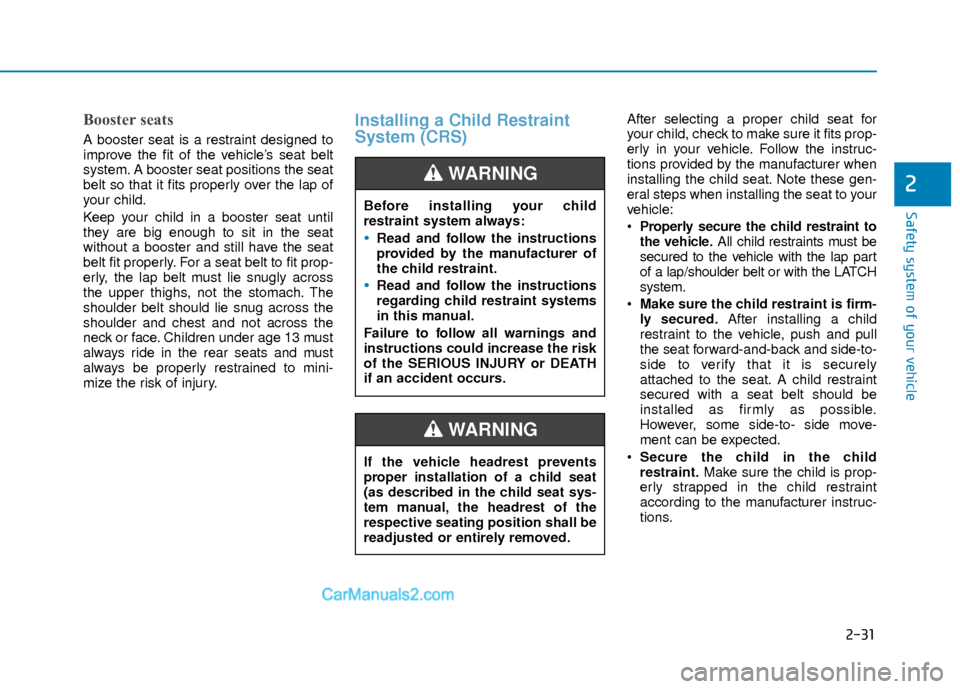
2-31
Safety system of your vehicle
2
Booster seats
A booster seat is a restraint designed to
improve the fit of the vehicle’s seat belt
system. A booster seat positions the seat
belt so that it fits properly over the lap of
your child.
Keep your child in a booster seat until
they are big enough to sit in the seat
without a booster and still have the seat
belt fit properly. For a seat belt to fit prop-
erly, the lap belt must lie snugly across
the upper thighs, not the stomach. The
shoulder belt should lie snug across the
shoulder and chest and not across the
neck or face. Children under age 13 must
always ride in the rear seats and must
always be properly restrained to mini-
mize the risk of injury.
Installing a Child Restraint
System (CRS)After selecting a proper child seat for
your child, check to make sure it fits prop-
erly in your vehicle. Follow the instruc-
tions provided by the manufacturer when
installing the child seat. Note these gen-
eral steps when installing the seat to your
vehicle:
Properly secure the child restraint to
the vehicle.All child restraints must be
secured to the vehicle with the lap part
of a lap/shoulder belt or with the LATCH
system.
Make sure the child restraint is firm-
ly secured. After installing a child
restraint to the vehicle, push and pull
the seat forward-and-back and side-to-
side to verify that it is securely
attached to the seat. A child restraint
secured with a seat belt should be
installed as firmly as possible.
However, some side-to- side move-
ment can be expected.
Secure the child in the child
restraint. Make sure the child is prop-
erly strapped in the child restraint
according to the manufacturer instruc-
tions.
Before installing your child
restraint system always:Read and follow the instructions
provided by the manufacturer of
the child restraint.
Read and follow the instructions
regarding child restraint systems
in this manual.
Failure to follow all warnings and
instructions could increase the risk
of the SERIOUS INJURY or DEATH
if an accident occurs.
WARNING
If the vehicle headrest prevents
proper installation of a child seat
(as described in the child seat sys-
tem manual, the headrest of the
respective seating position shall be
readjusted or entirely removed.
WARNING
Page 498 of 526
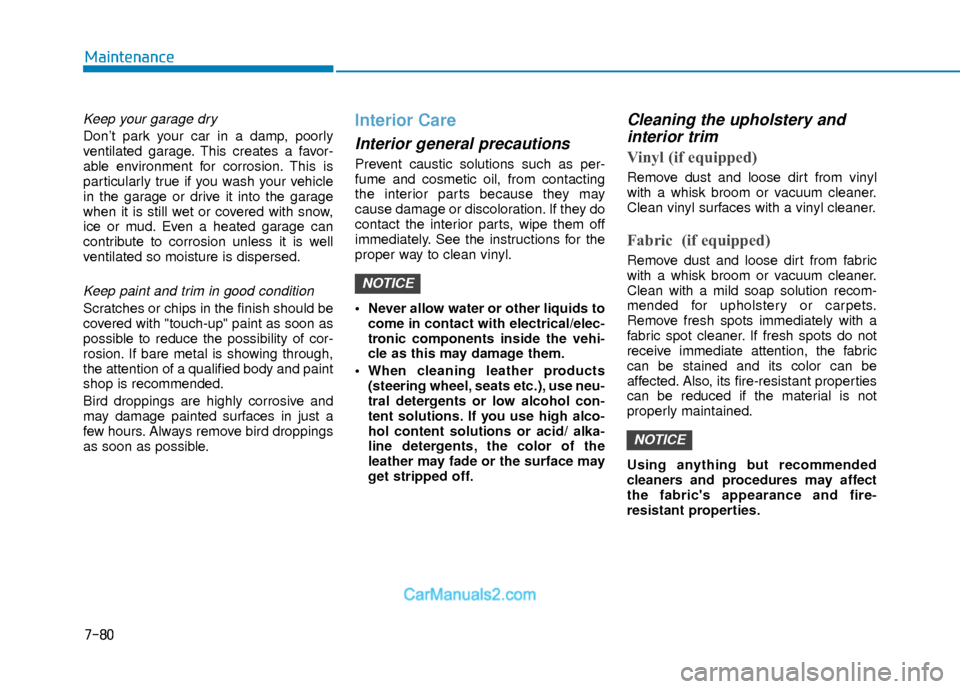
7-80
Maintenance
Keep your garage dry
Don’t park your car in a damp, poorly
ventilated garage. This creates a favor-
able environment for corrosion. This is
particularly true if you wash your vehicle
in the garage or drive it into the garage
when it is still wet or covered with snow,
ice or mud. Even a heated garage can
contribute to corrosion unless it is well
ventilated so moisture is dispersed.
Keep paint and trim in good condition
Scratches or chips in the finish should be
covered with "touch-up" paint as soon as
possible to reduce the possibility of cor-
rosion. If bare metal is showing through,
the attention of a qualified body and paint
shop is recommended.
Bird droppings are highly corrosive and
may damage painted surfaces in just a
few hours. Always remove bird droppings
as soon as possible.
Interior Care
Interior general precautions
Prevent caustic solutions such as per-
fume and cosmetic oil, from contacting
the interior parts because they may
cause damage or discoloration. If they do
contact the interior parts, wipe them off
immediately. See the instructions for the
proper way to clean vinyl.
Never allow water or other liquids tocome in contact with electrical/elec-
tronic components inside the vehi-
cle as this may damage them.
When cleaning leather products (steering wheel, seats etc.), use neu-
tral detergents or low alcohol con-
tent solutions. If you use high alco-
hol content solutions or acid/ alka-
line detergents, the color of the
leather may fade or the surface may
get stripped off.
Cleaning the upholstery andinterior trim
Vinyl (if equipped)
Remove dust and loose dirt from vinyl
with a whisk broom or vacuum cleaner.
Clean vinyl surfaces with a vinyl cleaner.
Fabric (if equipped)
Remove dust and loose dirt from fabric
with a whisk broom or vacuum cleaner.
Clean with a mild soap solution recom-
mended for upholstery or carpets.
Remove fresh spots immediately with a
fabric spot cleaner. If fresh spots do not
receive immediate attention, the fabric
can be stained and its color can be
affected. Also, its fire-resistant properties
can be reduced if the material is not
properly maintained.
Using anything but recommended
cleaners and procedures may affect
the fabric's appearance and fire-
resistant properties.
NOTICE
NOTICE
Page 499 of 526
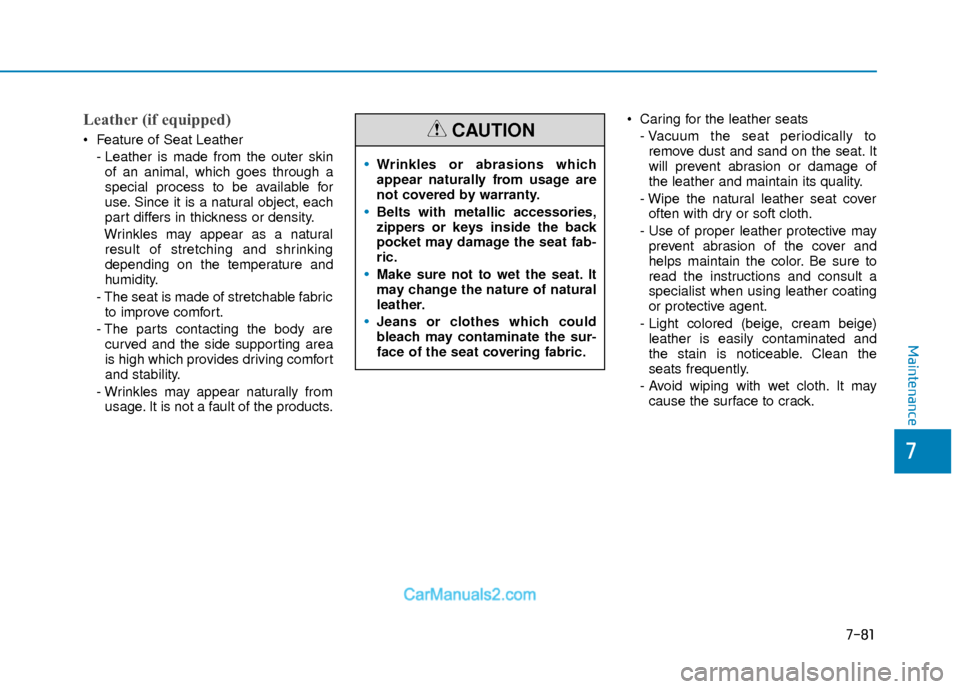
7-81
7
Maintenance
Leather (if equipped)
Feature of Seat Leather- Leather is made from the outer skinof an animal, which goes through a
special process to be available for
use. Since it is a natural object, each
part differs in thickness or density.
Wrinkles may appear as a natural result of stretching and shrinking
depending on the temperature and
humidity.
- The seat is made of stretchable fabric to improve comfort.
- The parts contacting the body are curved and the side supporting area
is high which provides driving comfort
and stability.
- Wrinkles may appear naturally from usage. It is not a fault of the products. Caring for the leather seats
- Vacuum the seat periodically toremove dust and sand on the seat. It
will prevent abrasion or damage of
the leather and maintain its quality.
- Wipe the natural leather seat cover often with dry or soft cloth.
- Use of proper leather protective may prevent abrasion of the cover and
helps maintain the color. Be sure to
read the instructions and consult a
specialist when using leather coating
or protective agent.
- Light colored (beige, cream beige) leather is easily contaminated and
the stain is noticeable. Clean the
seats frequently.
- Avoid wiping with wet cloth. It may cause the surface to crack.
Wrinkles or abrasions which
appear naturally from usage are
not covered by warranty.
Belts with metallic accessories,
zippers or keys inside the back
pocket may damage the seat fab-
ric.
Make sure not to wet the seat. It
may change the nature of natural
leather.
Jeans or clothes which could
bleach may contaminate the sur-
face of the seat covering fabric.
CAUTION
Page 500 of 526
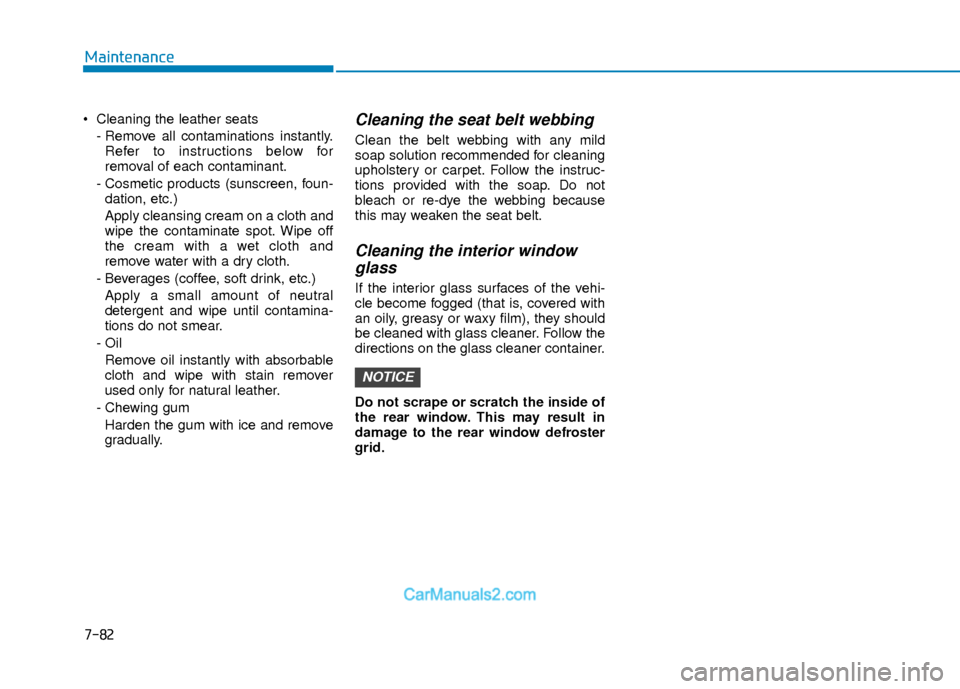
7-82
Maintenance
Cleaning the leather seats- Remove all contaminations instantly.Refer to instructions below for
removal of each contaminant.
- Cosmetic products (sunscreen, foun- dation, etc.)
Apply cleansing cream on a cloth and
wipe the contaminate spot. Wipe off
the cream with a wet cloth and
remove water with a dry cloth.
- Beverages (coffee, soft drink, etc.) Apply a small amount of neutral
detergent and wipe until contamina-
tions do not smear.
- Oil Remove oil instantly with absorbable
cloth and wipe with stain remover
used only for natural leather.
- Chewing gum Harden the gum with ice and remove
gradually.Cleaning the seat belt webbing
Clean the belt webbing with any mild
soap solution recommended for cleaning
upholstery or carpet. Follow the instruc-
tions provided with the soap. Do not
bleach or re-dye the webbing because
this may weaken the seat belt.
Cleaning the interior windowglass
If the interior glass surfaces of the vehi-
cle become fogged (that is, covered with
an oily, greasy or waxy film), they should
be cleaned with glass cleaner. Follow the
directions on the glass cleaner container.
Do not scrape or scratch the inside of
the rear window. This may result in
damage to the rear window defroster
grid.
NOTICE